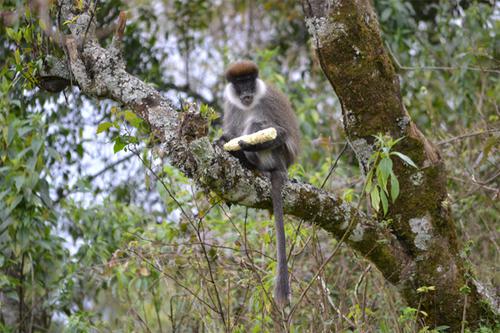当前位置:
X-MOL 学术
›
Am. J. Primatol.
›
论文详情
Our official English website, www.x-mol.net, welcomes your feedback! (Note: you will need to create a separate account there.)
Use of cultivated foods and matrix habitat by Bale monkeys in forest fragments: Assessing local human attitudes and perceptions.
American Journal of Primatology ( IF 2.4 ) Pub Date : 2019-12-03 , DOI: 10.1002/ajp.23074 Addisu Mekonnen 1, 2 , Peter J Fashing 1, 3 , Afework Bekele 2 , Nils Chr Stenseth 1, 2
American Journal of Primatology ( IF 2.4 ) Pub Date : 2019-12-03 , DOI: 10.1002/ajp.23074 Addisu Mekonnen 1, 2 , Peter J Fashing 1, 3 , Afework Bekele 2 , Nils Chr Stenseth 1, 2
Affiliation

|
Primates inhabiting human-modified landscapes often exploit matrix habitat to supplement their diet with cultivated foods, at times resulting in economic losses and conflict with local people. Understanding human-nonhuman primate interactions and the attitudes and perceptions of local people towards crop feeding species are crucial to designing effective species-based management plans. Over a 12-month period, we used scan sampling to study the consumption of cultivated foods and matrix use patterns by two habituated groups of Bale monkeys (Chlorocebus djamdjamensis), Ethiopian-endemic bamboo specialists, in two forest fragments (Kokosa and Afursa) set amidst human settlements and farmland in the southern Ethiopian Highlands. Further, we conducted interviews with local people to document their attitudes and perceptions towards Bale monkeys at the two sites. We found that Bale monkeys at Kokosa, a more degraded habitat by most measures, consumed significantly more cultivated foods than their counterparts at Afursa. Moreover, Bale monkeys at Kokosa spent significantly more time in the matrix than in the forest habitat, while monkeys at Afursa spent significantly less time in the matrix than in the forest habitat. Not surprisingly, local people displayed a more negative attitude towards monkeys inhabiting Kokosa than those inhabiting Afursa. The differences in Bale monkey cultivated food consumption and matrix use patterns-as well as in local people's attitudes and perceptions towards Bale monkeys-between Kokosa and Afursa are probably associated with differences in habitat structure, degree of habitat alteration, and land-use practices between the sites. We conclude that to ensure long-term coexistence between Bale monkeys and local people in human-modified landscapes, it is vital to incorporate nearby matrix habitats into management plans and to work closely with local communities to develop effective nonlethal crop protection strategies, thereby reducing the likelihood of negative interactions between Bale monkeys and humans.
中文翻译:

ale猴在森林碎片中使用的耕种食品和基质栖息地:评估当地人类的态度和看法。
居住在经过人类改造的景观中的灵长类动物经常利用矩阵栖息地来补充饮食,以种植的食物为食,有时会造成经济损失并与当地人发生冲突。了解人与人之间的灵长类动物相互作用以及当地人对农作物饲喂物种的态度和看法对于设计基于物种的有效管理计划至关重要。在12个月的时间里,我们使用扫描采样研究了两个森林碎片(Kokosa和Afursa)中两组习惯化的大包猴子(Chlorocebus djamdjamensis),埃塞俄比亚特有的竹子专家对耕作食品的消费和基质使用模式的情况。在埃塞俄比亚南部高地的人类住区和农田中。进一步,我们与当地人进行了访谈,以记录他们在这两个地点对大包猴的态度和看法。我们发现,在大多数情况下,科科萨(Kokosa)栖息地退化程度更高的大头猴消耗的耕种食物比阿富萨的同类大得多。此外,科科萨(Kokosa)的大头猴在矩阵中的停留时间比在森林中的要多得多,而阿富沙(Afursa)的猴子在矩阵中的花费比在森林中的要少得多。毫不奇怪,当地人对居住在科科萨的猴子表现出比居住在阿富沙的猴子更为消极的态度。大包猴耕种的食物消耗和基质使用方式以及当地人的差异 科科萨(Kokosa)和阿富沙(Afursa)之间对大包猴的态度和看法可能与生境结构,生境改变程度以及地点之间的土地使用方式的差异有关。我们得出的结论是,要确保在人工改造景观中的大头猴与当地人长期共存,将附近的矩阵栖息地纳入管理计划并与当地社区密切合作以制定有效的非致死性作物保护策略至关重要,从而减少大包猴与人之间负面互动的可能性。
更新日期:2020-04-13
中文翻译:

ale猴在森林碎片中使用的耕种食品和基质栖息地:评估当地人类的态度和看法。
居住在经过人类改造的景观中的灵长类动物经常利用矩阵栖息地来补充饮食,以种植的食物为食,有时会造成经济损失并与当地人发生冲突。了解人与人之间的灵长类动物相互作用以及当地人对农作物饲喂物种的态度和看法对于设计基于物种的有效管理计划至关重要。在12个月的时间里,我们使用扫描采样研究了两个森林碎片(Kokosa和Afursa)中两组习惯化的大包猴子(Chlorocebus djamdjamensis),埃塞俄比亚特有的竹子专家对耕作食品的消费和基质使用模式的情况。在埃塞俄比亚南部高地的人类住区和农田中。进一步,我们与当地人进行了访谈,以记录他们在这两个地点对大包猴的态度和看法。我们发现,在大多数情况下,科科萨(Kokosa)栖息地退化程度更高的大头猴消耗的耕种食物比阿富萨的同类大得多。此外,科科萨(Kokosa)的大头猴在矩阵中的停留时间比在森林中的要多得多,而阿富沙(Afursa)的猴子在矩阵中的花费比在森林中的要少得多。毫不奇怪,当地人对居住在科科萨的猴子表现出比居住在阿富沙的猴子更为消极的态度。大包猴耕种的食物消耗和基质使用方式以及当地人的差异 科科萨(Kokosa)和阿富沙(Afursa)之间对大包猴的态度和看法可能与生境结构,生境改变程度以及地点之间的土地使用方式的差异有关。我们得出的结论是,要确保在人工改造景观中的大头猴与当地人长期共存,将附近的矩阵栖息地纳入管理计划并与当地社区密切合作以制定有效的非致死性作物保护策略至关重要,从而减少大包猴与人之间负面互动的可能性。



























 京公网安备 11010802027423号
京公网安备 11010802027423号